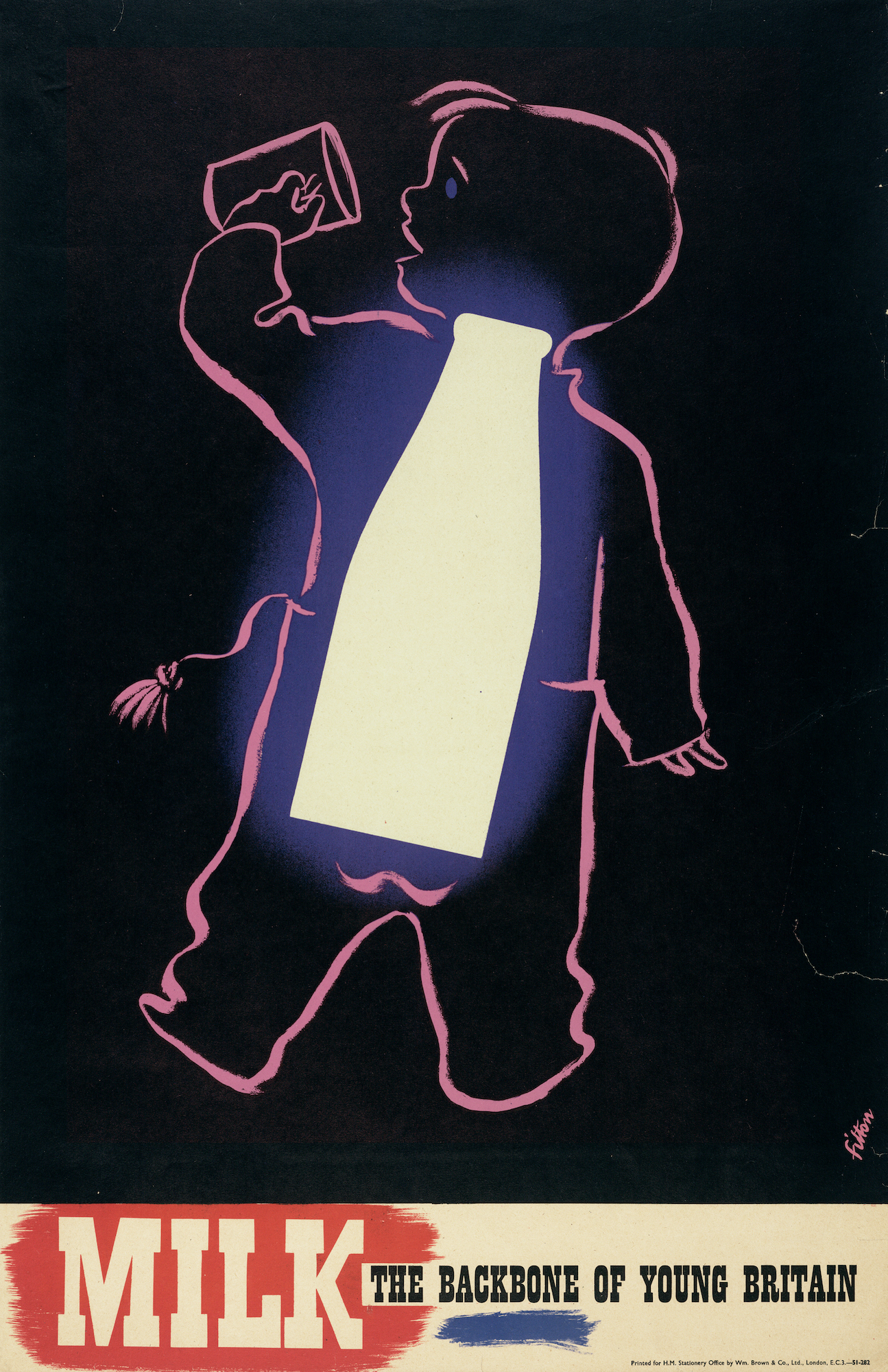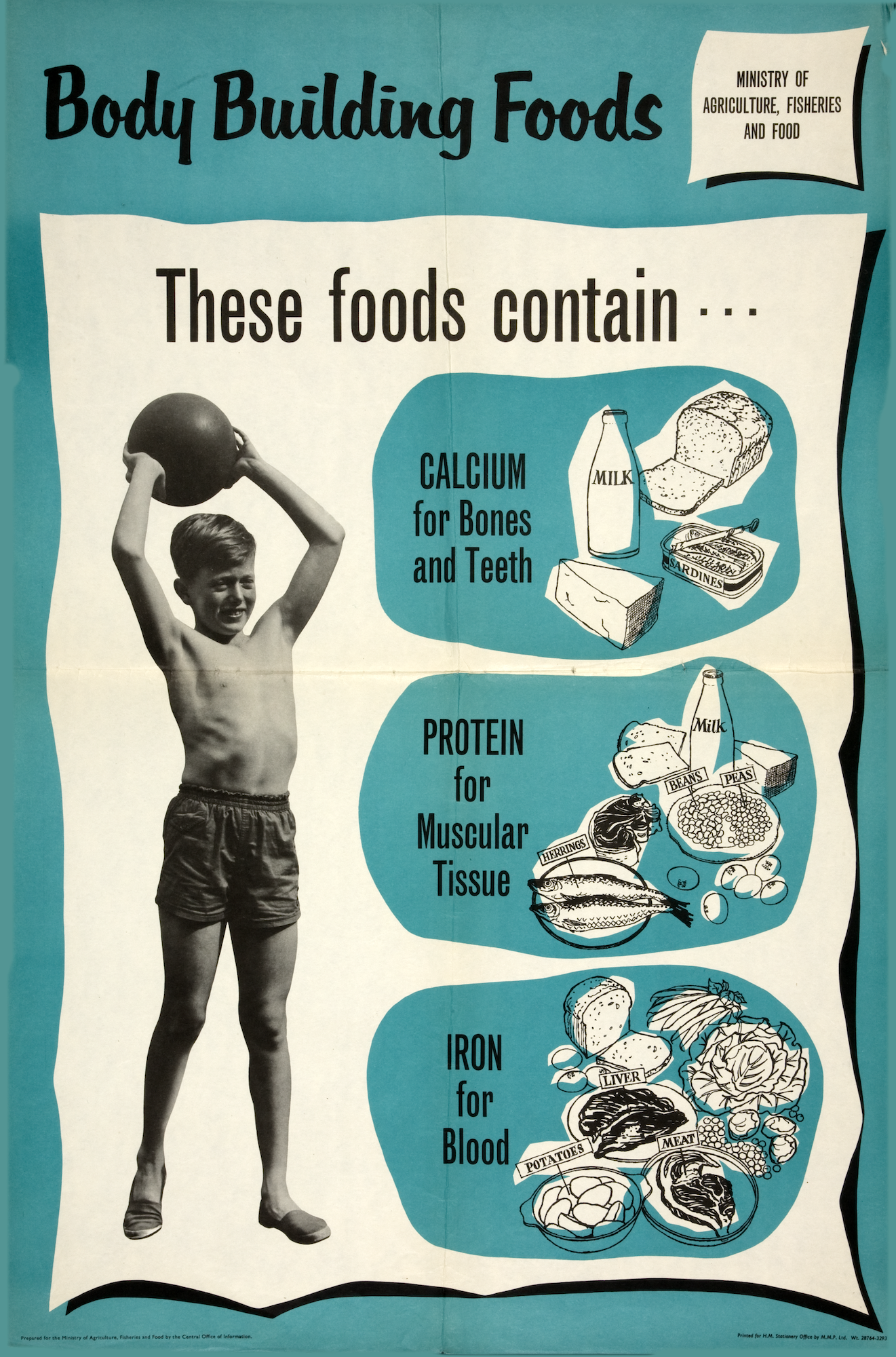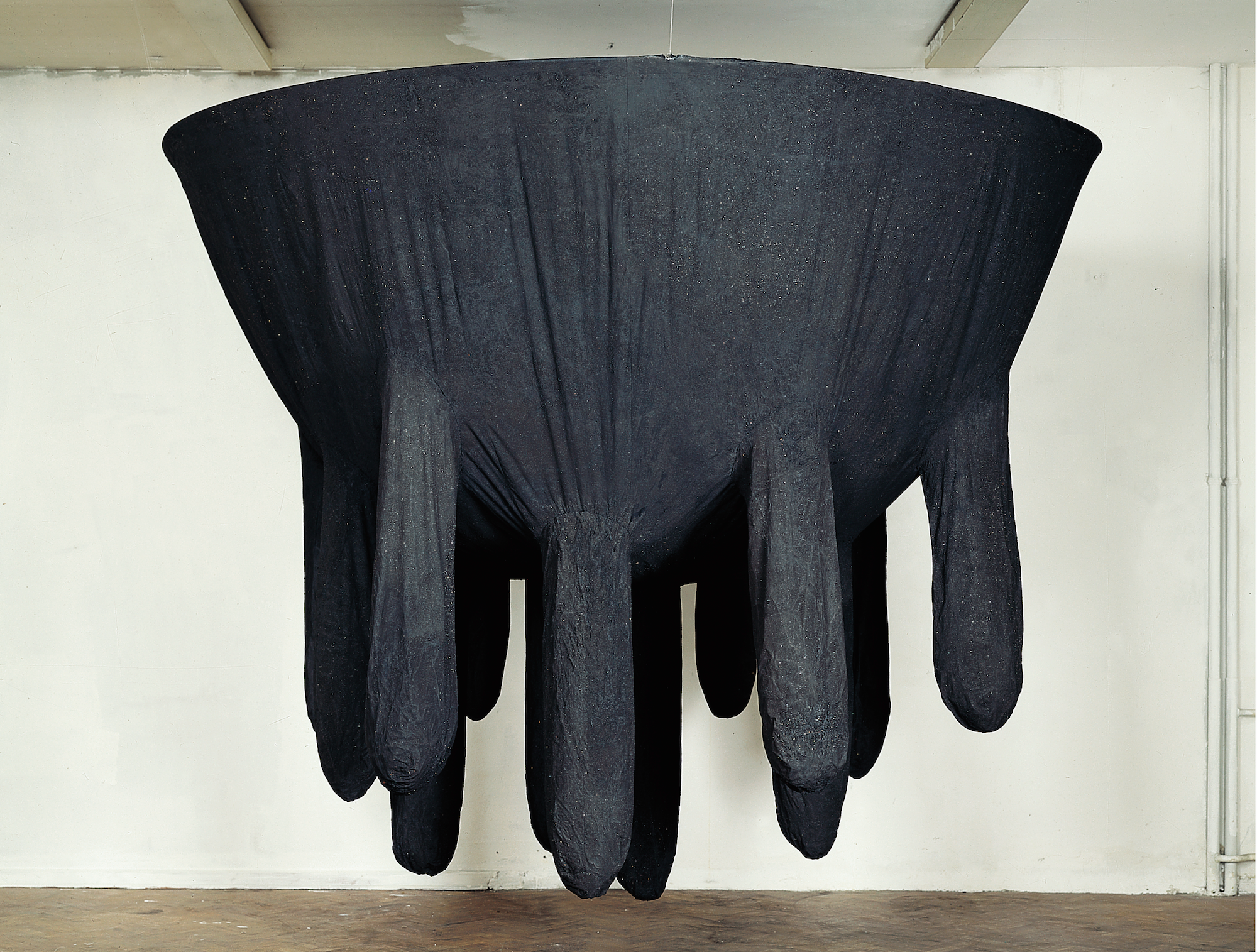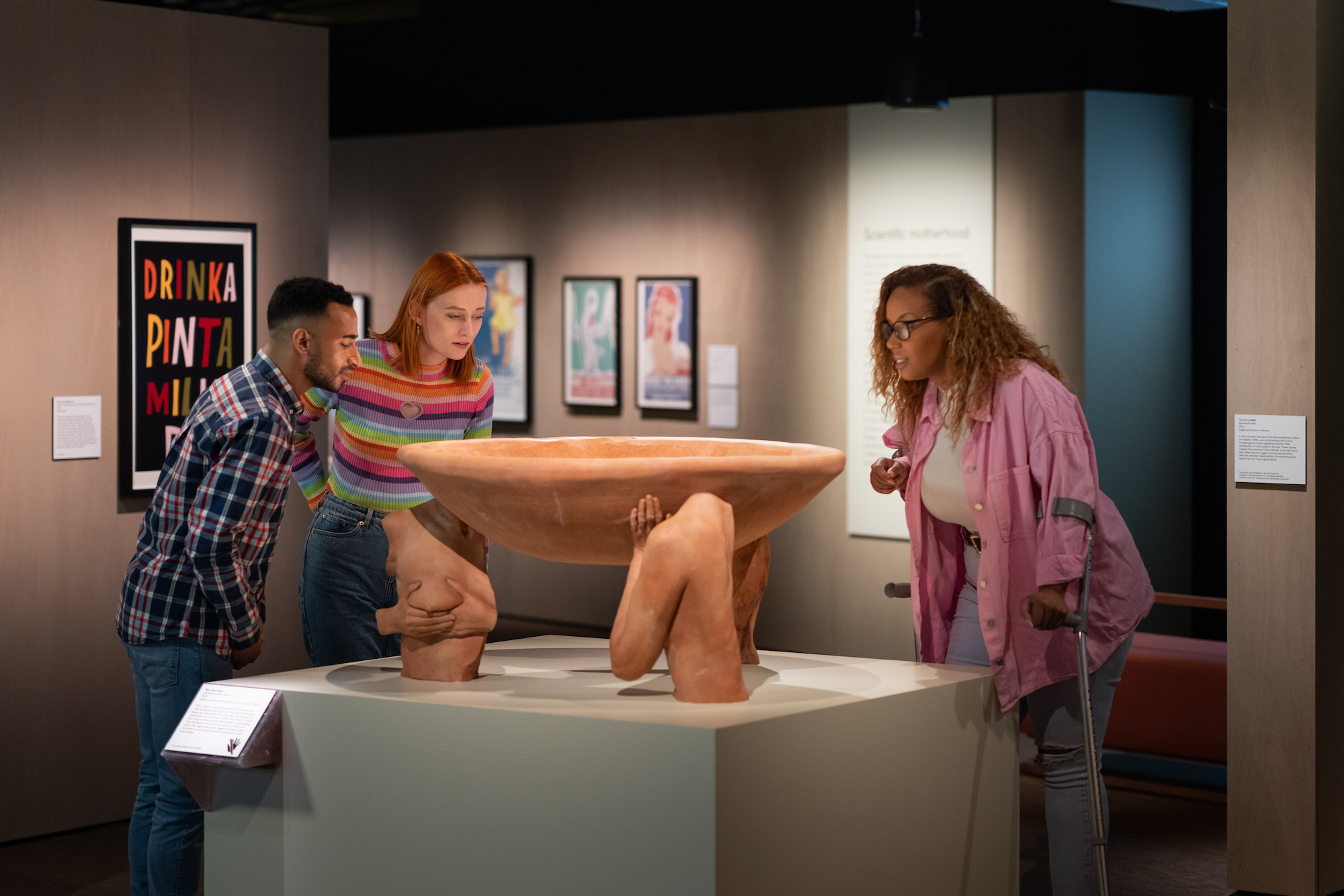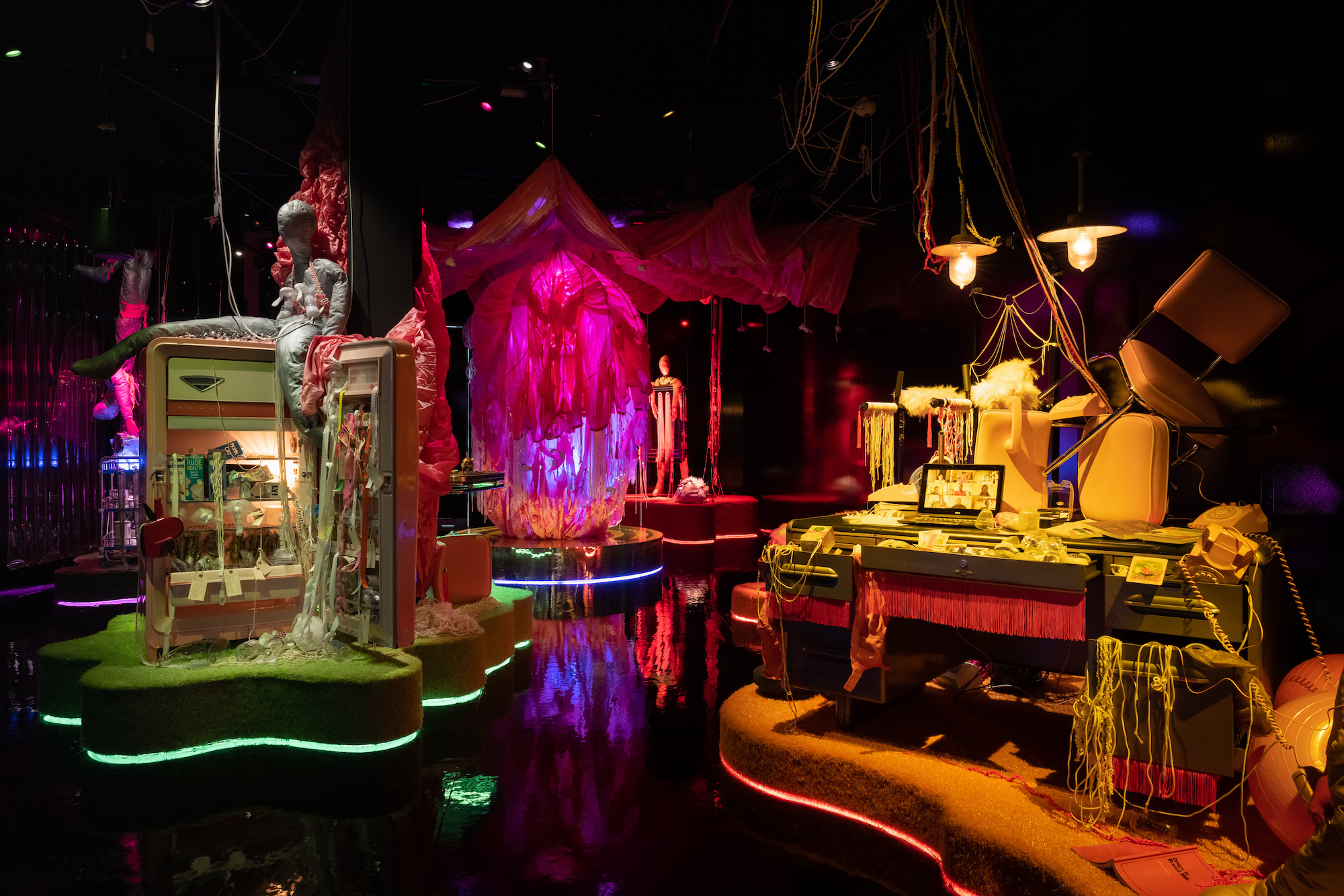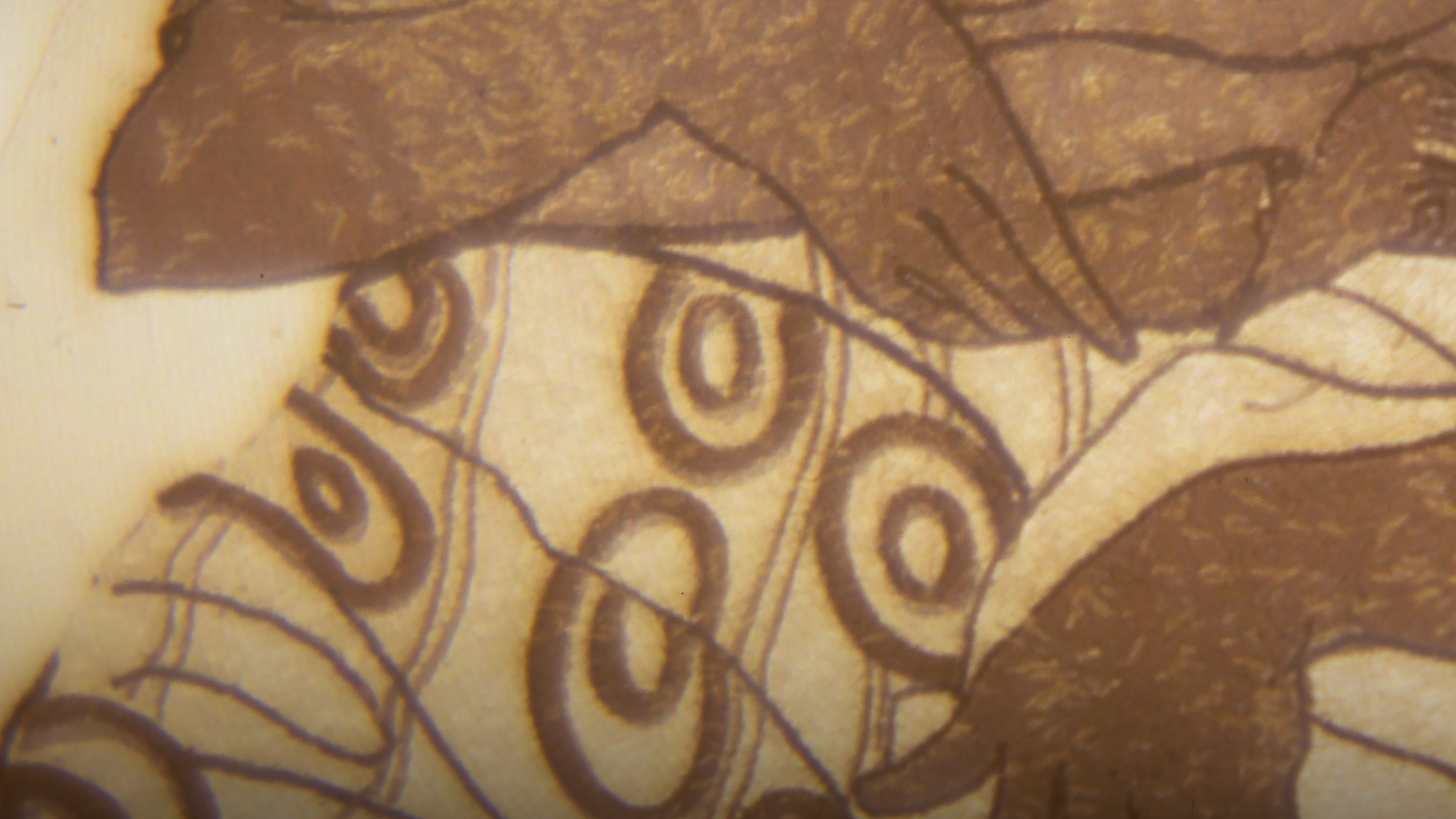Milk
Ilana Harris-Babou, Let Down Reflex, 2023, video still [Courtesy of the artist and Wellcome Collection, London]
Share:
Milk exists in the in-between. It pours from pregnant bodies and maps interspecies encounters, it is powdered, foamed, and fermented. It points to early development, recalls something of the inner child that persists, perhaps, into adult life—a hazy, liminal fluid.
In Milk [March30–September 10, 2023], the Wellcome Collection reckons with this substance. As told here, the story of milk is that of colonial power, erotics, and affect. According to one 1950s Ex-Cell-O Corporation (now Elopak) broadcast featured in the opening room, it is an “integral part of the story of man.”—a narrative dependent upon an imaginative link between human and nonhuman milk, one that fails, of course, to account for global majority lactose intolerance. What follows is a history of milk as a political substance, traced through photos of the British war effort, posters wherein milk unites the White American family, and repurposed pastoral paintings advertising milk’s natural goodness. Against this sanitized account, a counternarrative flows, grappling instead with milk as mess.
Milk: The backbone of young Britain [Courtesy of Wellcome Collection, London, © IWM (Art.IWM PST 4944)]
Body Building Foods: These foods contain … Calcium for Bones and Teeth, Protein for Muscular Tissue, Iron for Blood, Ministry of Information, 1954 [Courtesy of The National Archives, UK, and Wellcome Collection]
The opening space is dominated by Julia Bornefeld’s untitled and monumental coal-coated udders, artificially inflated and sagging under the weight of their own milk. In both material and subject matter, Bornefeld interrogates our preconceived notions of value and utility. She links the energy-giving properties and invasive extraction processes of milk and coal to consider mass production and exploitation. The sculpture works in concert with the exhibition’s other bookend—Jess Dobkin’s For What It’s Worth (2023), an installation staging sites of human milk extraction—to consider whether the value we place on milk necessarily commodifies the bodies from which it comes.
Julia Bornefeld, Untitled, 1995 [photo: Helmut Kunde; courtsey of the artist and ARTantide Gallery, Verona; Galerie Elisabeth & Klaus Thoman, Innsbruck/ Wien]
Enormous, abstracted, and isolated from a body, Bornefeld’s udders become a kind of worship object. Clementine Keith-Roach engages similar ideas in New Mourning II (2023) by using casts of her own body to depict weaning as a mourning process, and drinking vessels as symbolizing and usurping the nursing mother. Fragmented terracotta torsos squeeze their breasts and hold upright a saucer of milk, capturing the mournfulness of a fountain that doesn’t flow, of a breast that doesn’t pour. The work asks what it means to think of objects as extensions of the self, and to look for meaning in the malleability of clay.
Milk, installation view, 2023 [courtesy of Wellcome Collection, photo: Steven Pocock]
Each artist lays bare a contradiction: that milk-giving bodies are both central and invisible in modern human life.
Keith-Roach and Bornefeld’s earthy materials speak to the iconography of nearby Christian illustrations, which link the lactating mother to the fertile landscape. A 1618 depiction of Atalanta Fugiens presents the pregnant mother in the shape of the globe. Activist Lakisha Cohill’s Chocolate Milk Goddesses (2017) plays with this visual history. Cohill photographs her subjects in the rocky outdoors, redressing a lack of support for—or representation of—Black breastfeeding mothers by championing them in a traditional, natural landscape. At the same time, she subverts this visual code in her choice of a barren landscape, thereby refusing overused links between the productive land and abundant mothers.
Sarah Pucill’s Backcomb (1995) likewise unsettles traditional femininity. In her six-minute video, a black entanglement of hair tears through a set table, contaminating and upturning milk jugs and ultimately, like a magician, pulling away the tablecloth to carry off the crockery in a clattering bridal veil. Pucill disrupts the pristine whiteness that characterizes the virginal bride and pasteurized milk by reintroducing the unruly realities of animal bodies. Kristeva looms particularly large here, where hair and milk are couched as ambiguous, animated, erotic, and neither self nor other. Attending to one of our most abhorred contaminations—hair in food—Pucill asks what, in particular, we find repellent. Is repellence inherent in the thing itself, or does anxiety follow from the overflow of normal bounds?
Milk, installation view, 2023 [courtesy of Wellcome Collection, photo: Steven Pocock]
The meaning of milk sprawls like Pucill’s hairy mass. On one wall, a photo of milk rations sits alongside posters about milk’s nutritional benefits, based implicitly upon a White populace; tied to nation building, this superfood was later co-opted by white nationalists, as shown in a 2017 YouTube clip of American neo-Nazis chugging milk. Elsewhere, Melanie Jackson’s clay figurines sit with a digital display that maps milk across its many states of matter—powdered, congealed, or otherwise—and the animated flow of something like a Mister Whippy cascades toward small clay microbes and jugs with faces. It is a fever dream brought on by eating cheese, a vision of processed milk as increasingly alien.
Given how bodily excess and unsettled norms are showcased across much of the work, surprisingly little space is given explicitly to queerness. Beyond the Wellcome, projects such as Fusion Arts in Oxford’s Spilt Milk exhibition [February 2023] or the queer cabarets of theater company Milk Presents are among the reminders that milk is a prevalent symbol in queer communities. In Milk, one vitrine presents Liesel Burisch’s Queer Nursing (2020), a gender-expansive guide on chest-feeding infants. The text was produced by the artist’s own GORILLA MILK publishing enterprise (founded with Edi Danartono Winarni) which also gives its name to Burisch’s 2021 experimental video piece on an aging gorilla at Budapest Zoo—“Nobody is interested in saggy tit Liesel anymore.” A commission from Burisch on milk as a queer medium would have offered an enlightening accompaniment to Queer Nursing, or else the text could have been supplemented by video content from queer vloggers on induced lactation.
The wide-ranging and conflicted attachments to milk are captured most succinctly in Ilana Harris-Babou’s commission, Let Down Reflex (2023). It’s a film on milk: frothy white bubbles shift to the underside of a baby blanket, a nursing mother sings a lullaby inherited from an enslaved woman. Interwoven voices of the artist’s female relatives are embodied only by the milky fluids, as the women reflect upon experiences of Black motherhood. The work offers an intimate portrayal of breastfeeding as the outpour of maternal knowledge, milk as mythology. Spittle bubbles slide as a voice describes a baby spitting up, moving through the processes of consumption and regurgitation. The audio quotes Song of Solomon, whose character Ruth describes breastfeeding in terms of liquid gold, “the secret power Rumpelstiltskin had given her.” This reference to European fairytale interpolated into an African American text makes for a complexly layered lineage of meaning.
Ilana Harris-Babou, Let Down Reflex, 2023, video still [Courtesy of the artist and Wellcome Collection, London (CC-BY-NC-4.0)]
Harris-Babou’s narrow depth of field adds a dreamlike quality to the work. The ghostly fluids sometimes take on a cosmic quality to resemble the Milky Way. Let Down Reflex spans a vast scale, from the deeply intimate to the great expanse of human inheritance; equally, one voice describes breastfeeding as simply convenient. The work lives in the contradictions of motherhood. Its entanglements of pain and pleasure take on the specificity of Black motherhood and reference Black maternal death rates. It is perhaps best summarized by the inclusion of an extract from Toni Morrison’s Beloved: “I love you. You hurt me. You came back to me.”
Charting the historical, cultural, and scientific resonances of milk, the exhibition draws connections between protection and power. Across the works, milk closes the space between bodies. It destabilizes those things we typically consider natural, and it asks who gets to participate in the fantasy of motherhood. That Elopak broadcast relied upon an imaginative link between breastmilk and dairy products, and the exhibition itself might easily have fallen into the same trap by striving to do too much to distill this story of humanity. Yet, from formula to freeze-dried breastmilk, human milk so easily becomes other—a very slippery substance indeed.
Tallulah Griffith is an aspiring writer of lyrical essay and criticism. She was shortlisted for the Bloom Writing Contest and the 7th International Award for Art Criticism, and has had work published in Wasafiri, Viper’s Tongue, Tate Etc, and Hero Magazine. She likes discordant music and very tiny flowers.
